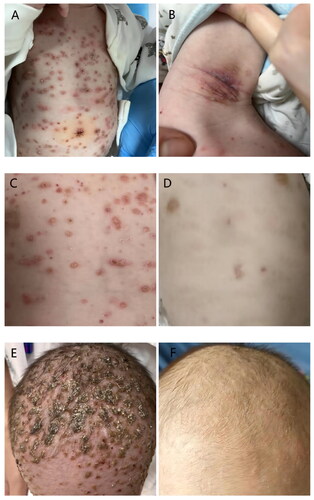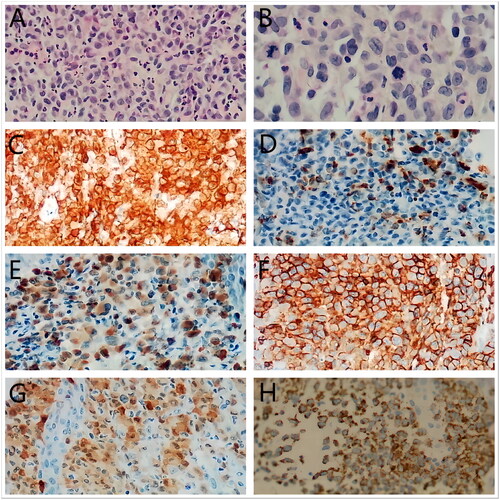Figures & data
Figure 1. Skin lesions including truncus, axilla, and scalp(A,B,C,E)before treatment. After two weeks of treatment, the truncus and scalp lesions basically subsided (D,F).

Figure 2. Histopathological features. (A,B) The characteristic infiltrate on hematoxylin and eosin (A) ×200, (B) ×400 was a large number of Langerhans cells with grooved or indented nuclei and abundant eosinophilic cytoplasms. Rare mitotic figures were seen and atypical form were presented. (C) CD1a(membranous), (D) CD68(cytoplasmic), (E) Langerin (cytoplasmic), (F) LCA(membranous), (G) S100 (cytoplasmic) staining showed positive results in the cell infiltrations(×200), (H) The mutant-specific antibody clone VE1 detects the BRAFV600E mutation by immunohistochemistry with 3+ strong cytoplasmic staining.

Figure 3. (A) Mutation load of BRAFv600E during treatment. We use the droplet digital PCR(ddPCR) in ctDNA to monitor mutant BRAF. When the result is less than 0.001%, the mutation load is shown as ‘<0.001%’ and the test result is reported as ‘negative’; when the result is greater than 0.001% or less than 0.1%, the mutation load is shown as ‘specific value’ and the test result is reported as ‘positive (for reference)’; when the result is greater than or equal to 0.1%, the mutation load is reported as ‘specific value’, and the test result is reported as ‘positive’. (B) The figure show the types and duration of the various therapies applied to this patient.

Data availability statement
The original contributions presented in this study are included in the article/supplementary material, further inquiries can be directed to the author.
